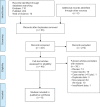EUS-through-the-needle microbiopsy forceps in pancreatic cystic lesions: A systematic review
- PMID: 32611848
- PMCID: PMC7980686
- DOI: 10.4103/eus.eus_23_20
EUS-through-the-needle microbiopsy forceps in pancreatic cystic lesions: A systematic review
Abstract
Pancreatic cystic lesions (PCLs) are being increasingly encountered in clinical practice, and sometimes, they can represent a diagnostic challenge. Recently, a through-the-needle micro forceps biopsy (MFB) device was introduced in the endosonography practice to facilitate EUS-guided sampling of PCLs. The aim was to perform a systematic review of studies evaluating the technical aspects, safety, and efficacy of the EUS-guided MFB for PCLs. A literature search was performed in three major databases, PubMed, Embase, and Web of Science in September 2019 using the search terms: "through-the-needle," "biopsy forceps," "microforceps," "endoscopic ultrasound," and "endosonography." Case reports and case series with <10 patients were excluded from the analysis. Altogether nine studies reporting on 463 patients were included in our systematic review. The mean age of the patients was 68.3 years, with a slight female predominance (60.9%). Most of the cysts were located in the body/tail of the pancreas (61.2%), with an overall mean size of 33 mm. The technical success of EUS-guided MFB was reported in 98.5%. The tissue acquisition yield reported was 88.2%, and the diagnostic accuracy was 68.6%. Adverse events were reported in 9.7%. EUS-guided MFB is technically feasible, safe, and has a high diagnostic accuracy for PCLs.
Keywords: EUS; diagnostic accuracy; microbiopsy forceps; pancreatic cyst.
Conflict of interest statement
None
References
-
- Tanaka M, Fernández-del Castillo C, Adsay V, et al. International consensus guidelines 2012 for the management of IPMN and MCN of the pancreas. Pancreatol. 2012;12:183–97. - PubMed
-
- Tanaka M, Castillo CF, Kamisawa T, et al. Revisions of international consensus Fukuoka guidelines for the management of IPMN of the pancreas. Pancreatol. 2017;17:738–53. - PubMed
Publication types
LinkOut - more resources
Full Text Sources
Other Literature Sources


